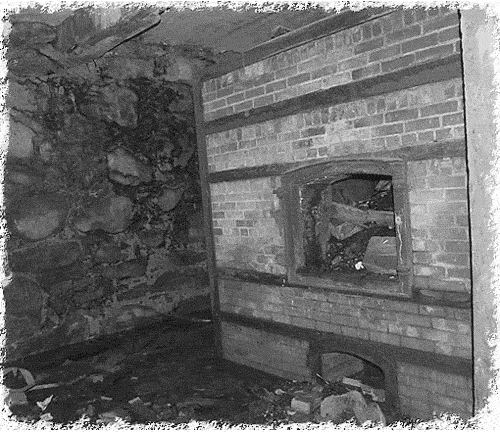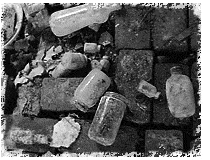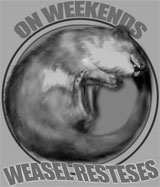One discarded shell at a time


I was feeling pretty out of sorts Saturday, until a friend called and asked this happy question:
“Want to go explore an abandoned Victorian insane asylum crematorium?”
And I go, “this isn’t like that abandoned military installation, where Security drives up and down in a white van looking for us, and we have to keep flopping down in the bramble bushes when they pass? Because that right there sucked pretty hard. I’ve still got scars.”
“Oh, nonono. This one’s along public nature trail and everything.” It is, too. That’s a little brain-hurty.
The Westboro Insane Hospital was built in the late 19th C as a homœopathic mental hospital: Beds, 1,235. Number of patients treated during last fiscal year, 1,855. Death rate, 6.5%. Most state hospitals had cemeteries on the grounds, plain and sad as they were. Westboro didn’t. This old American Journal of Psychiatry report on the condition of Westboro’s lunatic brains at autopsy makes me think the place indulged in another common practice: using the unclaimed bodies of inmates for medical research. In fact, the grand house on the grounds that I assumed belonged to the director was, in fact, the pathology lab and library. Afterwards, the empty husks were fed into the apparatus pictured above. Where the ash went is anybody’s guess.
Saturday was a hot, sunny day. At last. (Global warming has really let us down this Spring). A top-down-on-the-Weaselmobile kind of day. I think I was fighting some kind of bug. I felt all floaty and disconnected, like my head was drifting around all by itself, tethered to the rest of me by a long, colorful ribbon. Not an entirely inappropriate state for the day at hand.
It was about a thirty mile drive.
Parts of the complex are still in use as psychiatric facilities. Other buildings are boarded up. Typical 19th Century Dickensian madhouse architecture: half fru-fru gingerbread charm, half nightmares and leather restraints. There didn’t seem to be any outside security or gatekeeping at all. The parking lot was fullish, and something about it gave me a sudden wave of the creeps.Then I realized the cars were in a variety of colors, but every one was the identical make and model. Ah. State-owned fleet, then.
The road to the trailhead went down and around and ended at the shore of the pond. Sure enough, there were boats in the pond and civilian cars in the dirt lot and proper Department of Environmental Management trail markers nailed to trees around the water. It must have been — probably still is — land belonging to the hospital. Facilities of that kind were once self-contained communities, with farmland and woodland and industrial areas. It seemed an odd place to deliberately draw the public.
Beautiful forest, though. Lots of big, spooky, gnarly old-growth trees. The path we wanted was a smaller side path off the main path, a half mile away and on the opposite side of the pond from the hospital, but still a proper, marked public footpath. I suppose the idea was to isolate this outbuilding as far away as possible, but it must have been an eerie trip driving that particular cargo.
We came upon a slab of cement flush to the ground — maybe twelve feet by sixteen — with two manhole covers set in it and a bit of old wire around the perimeter. That, as it turns out, was the roof. Beside it, a ramp with a rail (all the better to steer your gurney, my dear) led down into the earth. Hang a left at the bottom. We stared into the dark for a minute without quite grasping what we were looking at.
“Ohhhh…it’s an oven, see? Just big enough for one person. No coffin or anything, I suppose. And there below it is the hole where you’d rake out the ashes.”
“Jesus.”
It was a small room with a puzzling arrangement of ducts and piping. There was open space behind the oven, and I wanted to work my way behind it, but I hadn’t worn my proper heavy boots and we didn’t bring a good flashlight. The floor was covered in broken glass and old bricks and about six inches of filthy water.
 The small room directly ahead at the foot of the ramp was puzzling. There were curious openings to the sky, and trees growing up through them. It looked as though it had been half filled with dirt at some point. There were a couple of chunks of an old terra cotta tiled floor leaning against piles of bricks and rusted pipes and grates and other rubbish.
The small room directly ahead at the foot of the ramp was puzzling. There were curious openings to the sky, and trees growing up through them. It looked as though it had been half filled with dirt at some point. There were a couple of chunks of an old terra cotta tiled floor leaning against piles of bricks and rusted pipes and grates and other rubbish.
At the far end, bricks had been loosely placed in the dirt to form a small flat surface. On top of this, a few dozen bottles. Not the usual smashed whiskey bottles you find in the woods, but medical vials of various sizes. No labels. One in particular looked old and slightly melted. There were a number of microscopy slides, unbroken. One pair had a wad of human head hair pressed between them. Not a properly prepared specimen; a loose hunk of hair.
Dead people don’t need medicine. What were these doing here? I guess they must have used this furnace to burn medical waste, too. We met a dozen dog walkers and joggers on the path; why were these old things still here, lying in plain view while the world passes the door every day and the room around them falls to bits?
All in all, as urban explorations go, a small, sad adventure. Sadder still: we saw no the real live inmates out in the sun today.
Tomorrow: something really spooky. (If I get time. Going to be a real tight sphincter of a Monday for Weasel).
April 23, 2007 — 7:35 am
Comments: 9












